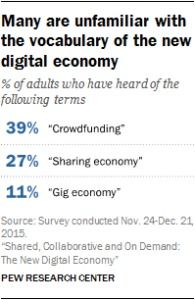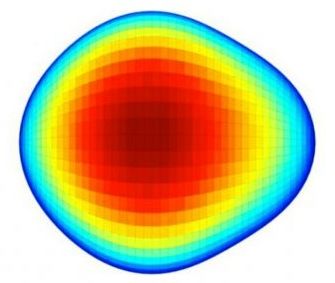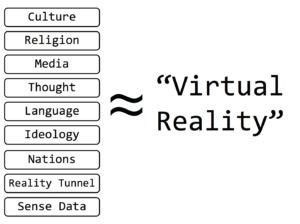Page 10580
Jun 29, 2016
Smart Dust Is Coming: New Camera Is the Size of a Grain of Salt
Posted by Klaus Baldauf in categories: 3D printing, computing, mobile phones
Miniaturization is one of the most world-shaking trends of the last several decades. Computer chips now have features measured in billionths of a meter. Sensors that once weighed kilograms fit inside your smartphone. But it doesn’t end there.
Researchers are aiming to take sensors smaller—much smaller.
In a new University of Stuttgart paper published in Nature Photonics, scientists describe tiny 3D printed lenses and show how they can take super sharp images. Each lens is 120 millionths of a meter in diameter—roughly the size of a grain of table salt—and because they’re 3D printed in one piece, complexity is no barrier. Any lens configuration that can be designed on a computer can be printed and used.
Continue reading “Smart Dust Is Coming: New Camera Is the Size of a Grain of Salt” »
Jun 28, 2016
Chatbot lawyer overturns 160,000 parking tickets in London and New York
Posted by Dan Kummer in categories: law, robotics/AI
Free service DoNotPay helps appeal over $4m in parking fines in just 21 months, but is just the tip of the legal AI iceberg for its 19-year-old creator.
Jun 28, 2016
A Brooklyn startup that’s armed with $40 million is growing real meat and leather in a lab
Posted by Dan Kummer in category: food
Modern Meadow uses skin cells to grow strips of real leather that can be turned into everything from purses to shoes.
Jun 28, 2016
The Inventors of the Internet Are Trying to Build a Truly Permanent Web — By Klint Finley | Wired
Posted by Odette Bohr Dienel in category: internet
“What would you do right now if you wanted to read something stored on a floppy disk? On a Zip drive? In the same way, the web browsers of the future might not be able to open today’s webpages and images …”
Jun 28, 2016
An AI Just Defeated Human Fighter Pilots in An Air Combat Simulator
Posted by Phillipe Bojorquez in category: robotics/AI
Air combat veterans proved to be no match for an artificial intelligence developed by Psibernetix. ALPHA has proven to be “the most aggressive, responsive, dynamic and credible AI seen to date.”
Retired United States Air Force Colonel Gene Lee recently went up against ALPHA, an artificial intelligence developed by a University of Cincinnati doctoral graduate. The contest? A high-fidelity air combat simulator.
And the Colonel lost.
Continue reading “An AI Just Defeated Human Fighter Pilots in An Air Combat Simulator” »
Jun 28, 2016
New Form Of Atomic Nuclei Just Confirmed, And it Suggests Time Travel is Impossible
Posted by Phillipe Bojorquez in categories: physics, time travel
A group of scientists confirmed that there is a pear-shaped nucleus. Not only does this violate some laws in physics, but also suggests that time travel is not possible.
A new form of atomic nuclei has been confirmed by scientists in a recent study published in the journal Physical Review Letters. The pear-shaped, asymmetrical nuclei, first observed in 2013 by researchers from CERN in the isotope Radium-224, is also present in the isotope Barium-144.
This is a monumental importance because most fundamental theories in physics are based on symmetry. This recent confirmation shows that it is possible to have a nuclei that has more mass on one side than the other. “This violates the theory of mirror symmetry and relates to the violation shown in the distribution of matter and antimatter in our Universe,” said Marcus Scheck of University of the West of Scotland, one of the authors of the study.
 I’m curious if readers of this blog, futurists or otherwise, were as surprised as I was to see the Pew Research Center report last month about how, to the average American, some of the biggest digital economy companies and concepts are still relatively unknown. A few highlights:
I’m curious if readers of this blog, futurists or otherwise, were as surprised as I was to see the Pew Research Center report last month about how, to the average American, some of the biggest digital economy companies and concepts are still relatively unknown. A few highlights:
- 61% of Americans have never heard of the term “crowdfunding.”
- 73% are not familiar with the term “sharing economy.”
- 89% are not familiar with the term “gig economy.”
This was a reminder to me that the digital economy is still far from mainstream, and I think we need to keep that in mind when we analyze new technologies. But there’s another reason the report caught my eye, which is that it I think it’s another good example of a human ecosystem, in this case the digital economy, exhibiting signs of Postnormal Times (PNT). The digital economy is famous for making our lives easier, cutting out various middlemen and red tape to get what the consumer actually wants: a bed, not a grand lobby, a ride, not a car. This seems very normal in terms of the evolution of consumer needs.
But according to Sardar and Sweeney, “many ‘normal’ systems will not continue to operate ‘normally’ in PNT—sooner or later, the 3Cs will have a direct or indirect impact on them.” It may sound somewhat doomsday, but it’s not. PNT is nothing to fear, but a way of observing the world; evidence of the 3Cs are just indicators that a system is evolving and changing, and lets us know that our responses need to change in kind.
One of those Cs stands for “contradictions.” Though contradiction is of course ‘normal,’ the contradiction between the relatively small slice of consumers being served by Uber and AirBNB doesn’t mesh with the massive values (AirBNB worth $30Billion) associated with such startups. This is where my PNT radar goes off.
Jun 28, 2016
How VR Gaming will Wake Us Up to our Fake Worlds
Posted by Odd Edges in categories: architecture, augmented reality, economics, entertainment, ethics, futurism, holograms, homo sapiens, internet, journalism, philosophy, posthumanism, virtual reality
Human civilization has always been a virtual reality. At the onset of culture, which was propagated through the proto-media of cave painting, the talking drum, music, fetish art making, oral tradition and the like, Homo sapiens began a march into cultural virtual realities, a march that would span the entirety of the human enterprise. We don’t often think of cultures as virtual realities, but there is no more apt descriptor for our widely diverse sociological organizations and interpretations than the metaphor of the “virtual reality.” Indeed, the virtual reality metaphor encompasses the complete human project.
Virtual Reality researchers, Jim Blascovich and Jeremy Bailenson, write in their book Infinite Reality; “[Cave art] is likely the first animation technology”, where it provided an early means of what they refer to as “virtual travel”. You are in the cave, but the media in that cave, the dynamic-drawn, fire-illuminated art, represents the plains and animals outside—a completely different environment, one facing entirely the opposite direction, beyond the mouth of the cave. When surrounded by cave art, alive with movement from flickering torches, you are at once inside the cave itself whilst the media experience surrounding you encourages you to indulge in fantasy, and to mentally simulate an entirely different environment. Blascovich and Bailenson suggest that in terms of the evolution of media technology, this was the very first immersive VR. Both the room and helmet-sized VRs used in the present day are but a sophistication of this original form of media VR tech.
Tags: culture, oculus rift, Society, virtual reality, VR
Jun 28, 2016
The Top Ten Reasons I Believe Vaccine Safety Is an Epic Mass Delusion
Posted by Eric Baum in categories: biotech/medical, ethics, existential risks, government, health, life extension, policy, rants, science, scientific freedom
Its painful to bear views that make many think I’m an imbicile and dislike me. So please, if anybody has a rational argument why any of this is wrong, I beg to be enlightened. I’ve set up a diagram for the purpose that will support you to add your criticism exactly where it is pertinent. https://tssciencecollaboration.com/graphtree/Are%20Vaccines%20Safe/406/4083
(1) The National Academy’s Reviews Of Vaccine Safety
The Institute of Medicine of the National Academies has provided several multi-hundred page surveys studying the safety of vaccines, but rather than reassuring, these itemize some iatrogenic conditions being caused, and pronounce the scientific literature inadequate to say whether most others are. The 2011 Institute of Medicine (IOM) Review[1] looked at 146 vaccine-condition pairs for causality, reporting:
- 14 for which the evidence is said to convincingly support causality, the vaccine is causing the condition.
- 4 where the evidence is said to favor acceptance.
- 5 where the evidence is said to favor rejection, including MMR causing autism.
- 123 where the evidence is said insufficient to evaluate.
The 2003 IOM Review on multiple vaccines said[2]:
“The committee was unable to address the concern that repeated exposure of a susceptible child to multiple immunizations over the developmental period may also produce atypical or non-specific immune or nervous system injury that could lead to severe disability or death (Fisher, 2001). There are no epidemiological studies that address this.”
and:
“the committee concludes that the epidemiological and clinical evidence is inadequate to accept or reject a causal relationship between multiple immunization and an increased risk of allergic disease, particularly asthma.”
- None of the IOM Safety Reviews[1][2][3][4] addressed the aluminum (for example whether the aluminum is causing autism), or mentioned contaminants, or discussed animal models although they had concluded as just quoted there is generally no epidemiological or clinical data worth preferring.
(2) The Aluminum.
Alum was added to vaccines back in the 1920’s, with no test of parenteral toxicity until recently[5], because it prods the immature immune system out of its normal operating range.[6] Maybe they figured aluminum is common in the environment, but injection bypasses half a dozen evolved sequential filters that normally keep it out of circulatory flow during development. Vaccines put hundreds of times as much aluminum into infants’ blood as they would otherwise get, and in an unnatural form that is hard for the body to remove.[7][8 (cfsec 4.2)][9]. The published empirical results indicate its highly toxic.
Continue reading “The Top Ten Reasons I Believe Vaccine Safety Is an Epic Mass Delusion” »
















